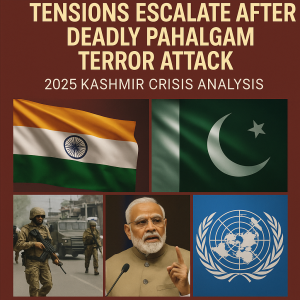India–Pakistan Tensions Escalate After Deadly Pahalgam Terror Attack 2025 : Kashmir Crisis Analysis

India–Pakistan Tensions
India–Pakistan Tensions Escalate After Deadly Pahalgam Terror Attack 2025 : Kashmir Crisis Analysis
India–Pakistan Tensions Escalate After Deadly Pahalgam Terror Attack 2025 On April 22, 2025, tragedy struck the serene valleys of Pahalgam in Jammu and Kashmir, India, when 26 people, including tourists and pilgrims, were killed in a brutal terror attack. The attackers, allegedly affiliated with a group calling itself the “Kashmir Resistance,” ambushed a convoy near the popular tourist site, triggering nationwide outrage and international concern.
The Indian government swiftly pointed fingers at Pakistan for sponsoring cross-border terrorism, while Pakistan vehemently denied involvement. In the days that followed, the regional conflict took a sharp turn with airspace bans, diplomatic expulsions, military deployments, and a global call for de-escalation.
The Pahalgam Attack: What Happened?
India–Pakistan Tensions Escalate After Deadly Pahalgam Terror Attack 2025 The attack occurred in the Baisaran Valley region, a known tourist spot in Pahalgam, killing 26 civilians and injuring dozens. Most of the victims were Hindu pilgrims from states like Uttar Pradesh and Gujarat, and one Nepali national was also reported among the deceased.
Indian intelligence agencies quickly attributed the attack to a terror outfit believed to operate from Pakistan-occupied Kashmir (PoK). According to preliminary investigations, the assault was premeditated and orchestrated with military precision.
Prime Minister Narendra Modi returned early from a diplomatic tour and declared a “decisive response” against the perpetrators. In his statement, Modi said:
“This is not just an attack on civilians—this is an assault on the spirit of India. We will ensure the masterminds pay beyond imagination.”
India’s Swift and Strategic Response
India–Pakistan Tensions Escalate After Deadly Pahalgam Terror Attack 2025
1. Airspace Closure to Pakistani Aircraft
On April 30, India suspended all Pakistani airlines from flying over Indian airspace until at least May 23. This move significantly impacted Pakistan International Airlines (PIA) operations to Southeast Asia and the Gulf. The action was reciprocal after Pakistan closed its airspace to Indian carriers just days before.
2. Suspension of the Indus Waters Treaty
In a bold move, India announced the suspension of the 1960 Indus Waters Treaty—an essential bilateral agreement that governs the distribution of rivers flowing from India to Pakistan. Indian officials cited Pakistan’s “continued support for terrorism” as justification. New Delhi stated it would withhold Pakistan’s water shares until Islamabad “credibly and irreversibly abjures terrorism.”
3. Diplomatic and Economic Sanctions
India expelled several Pakistani diplomats, including defense attachés, and revoked special visa privileges for Pakistani citizens. Trade routes through the Attari-Wagah border were shut down, impacting essential cross-border goods. New Delhi also halted diplomatic engagement on all bilateral matters.
Pakistan’s Reaction: Denial and Retaliation
India–Pakistan Tensions Escalate After Deadly Pahalgam Terror Attack 2025 Pakistan’s Prime Minister Shehbaz Sharif quickly condemned the attack but denied any involvement. In a conversation with U.S. Secretary of State Mike Rubio, he demanded an international investigation, claiming India was attempting to manufacture a pretext for escalation.
False Flag Allegations
India–Pakistan Tensions Escalate After Deadly Pahalgam Terror Attack 2025 Pakistan’s Defense Minister Khawaja Asif went as far as to suggest that the attack might have been a “false flag operation” orchestrated by Indian intelligence agencies to derail regional peace talks and justify aggressive moves in Kashmir.
Countermeasures by Islamabad
Pakistan responded with its own set of retaliatory actions:
- Banning Indian overflights through Pakistani airspace.
- Suspending diplomatic engagements and trade relations with India.
- Calling India’s Indus Treaty suspension an “act of war.”
Rising Tensions Along the Line of Control (LoC)
India–Pakistan Tensions Escalate After Deadly Pahalgam Terror Attack 2025 Clashes along the Line of Control resumed after nearly two years of relative calm. Both sides exchanged gunfire and heavy shelling in the Rajouri and Kupwara sectors. India increased military presence across the Jammu and Kashmir region, while Pakistan moved artillery and troops closer to forward positions.
Civilians on both sides of the border reported fear, displacement, and a return to the dark days of regular hostilities. Emergency bunkers were opened in villages near the LoC, and border schools were closed as a precaution.
International Response: Calls for Calm and Mediation
India–Pakistan Tensions Escalate After Deadly Pahalgam Terror Attack 2025
United States: Support for India but Urging Restraint
The United States strongly condemned the Pahalgam attack and expressed solidarity with India. President Donald Trump stated,
“We support India’s right to defend its citizens and bring terrorists to justice.”
However, U.S. officials also urged restraint and encouraged both nations to de-escalate. Washington is reportedly in continuous contact with both Islamabad and New Delhi to prevent a wider conflict.
United Nations and China: Appeal for Peace
The United Nations called for “maximum restraint” and offered diplomatic support to resolve the dispute. China, while avoiding direct blame, encouraged both countries to uphold regional peace and offered to mediate the situation if required.

Geopolitical Stakes: A Nuclear-Shadowed Rivalry Reignites
India–Pakistan Tensions Escalate After Deadly Pahalgam Terror Attack 2025 India and Pakistan, both nuclear powers, have a long history of hostility centered on Kashmir. This latest episode underscores the volatility of their relationship and the risk of miscalculation.
Water as a Weapon?
India’s move to suspend the Indus Waters Treaty introduces water security as a strategic tool. Experts warn this could set a dangerous precedent, especially in an era of climate change and dwindling water resources.
Pakistan, whose agriculture relies heavily on Indus waters, labeled the move a provocation that could spiral into open conflict.
What’s Next? The Road Ahead
India–Pakistan Tensions Escalate After Deadly Pahalgam Terror Attack 2025
1. Potential for Dialogue
There is still room for diplomacy. Countries like Iran, UAE, and even Russia have expressed willingness to facilitate back-channel talks. However, no official dialogue has been initiated yet.
2. Domestic Political Implications
In India, the government’s strong stance is popular domestically, especially with elections around the corner. In Pakistan, the civilian government is under pressure from both the military and the public to resist any “humiliation.”
3. Long-Term Impact on Regional Stability
The Kashmir crisis of 2025 is another chapter in a long-running saga. Unless there’s international pressure and willingness from both sides to resolve core issues—especially terrorism and Kashmir—peace will remain elusive.
Conclusion: A Crisis Demanding More Than Just Condemnations
India–Pakistan Tensions Escalate After Deadly Pahalgam Terror Attack 2025 The Pahalgam terror attack has once again pushed South Asia to the brink of a serious military and diplomatic crisis. While both India and Pakistan maintain hardened positions, the region and the world cannot afford another war.
This is a moment for courageous leadership, meaningful dialogue, and international mediation. Without these, the cycles of violence and retaliation will continue to put millions at risk.





The tensions between India and Pakistan have escalated significantly, with both nations taking drastic measures against each other. The suspension of airspace and the Indus Waters Treaty has added to the already strained relations. Diplomatic expulsions and the halt of trade routes have further deepened the crisis. The global community is urging both sides to de-escalate and find a peaceful resolution. How can these two nations move towards a sustainable and peaceful coexistence amidst such heightened tensions?